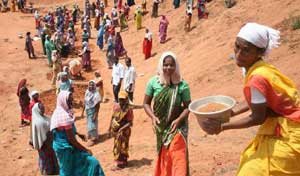MGNREGA: A New Hope from NDA Government by Dr. Sarda Prasad,
JNU

MGNREGA is a right based approach for citizen of India. It
gives right to work for livelihood. It has both positive and negative impacts in
agriculture. Recently government has announced that NREGA should link with
agriculture that is need of hours. It is necessary to regularised NREGA for
better and efficient use of it in agriculture. This paper explain how government
and farmers should work together for sustainable agriculture. The main objective
of this article to link NREGA and agriculture with the consent of labour and
farmers. This paper try to solve the present problems arises due to NREGA in
agriculture sector. Discussion in paper is based on primary survey and
observations from fields collected during May to August 2011 in Bundelkhand
region, Uttar Pradesh.
NDA government has come in power with various developmental
schemes. Government seeks to link NREGS to agriculture that is new rays of hope
for labours and farmers. These two active agents of agriculture can fill the gap
between supply and demand of food in India. Due to bright light effects of urban
areas, new generation is not interested to work in agriculture as they seems it
is labourious and low status job. It indicates labour shortage in agriculture in
the future. Mechanization is an alternate of labour but it has some limitations
such as high cost of machineries, small landholdings, and high cost of
maintenance during offseason. Food producers are decreasing day by day and
consumers has increasing in higher rate, resultant of this increase prices of
food items. In this grim situation government has given positive indication
towards agriculture sector by proposing MGNREGA link to agriculture. We would be
grateful if it is success. But, how NREGA links with agriculture is a matter of
debate. We have some ideas on this issue are discussing forth.
MGNREGA workers should be available for agriculture work in
the farmers’ field. MGNREGA has positive and negative impacts on agriculture and
rural households as on one hand earning of the labour/small farmers fromMGNREGA
are being used in agriculture and household expenditure and on the other it is
responsible for the increasing wage rate in agriculture. MGNREGA gives equal
opportunity to men and women in terms of work and wage rates. Women are happy
with MGNREGA because of on time payment of wages, whereas in agriculture they
get lower wages than men (Sivanandan, 2012). It has improved rural
socio-economic conditions amonglandless and marginal farmers, as well as
improved environmental related components. These components are water and soil
conservation (Tiwari, et al.,2011). Villages were using 75 per cent of their
earnings from MGNREGA in improving irrigation and infrastructural facilities and
have therefore increase land rent. Card holders have used their money to
introduce chemical fertilizers and machinery in their fields. The National Rural
Employment Guarantee Act (now Mahatma Gandhi NREGA) was launched in 2005-06 for
rural poor to provide 100 days of public works in 200 districts, and in 2008 all
the districts of the country were covered under MGNREGA in three phases. Under
this scheme a below poverty line (BPL) household head has one job card for 100
days in a year. This developmental programmehas played a major role in the rural
areas and has led toincreased household income, empowerment of women through
wage rates equal to their male counterparts, independence of labour from land
owners for survival and given labour the right to job. If a job card holder is
unable to get work within 15 days, the state government is entitled to pay
unemployment allowance to the card holders.
The goals of MGNREGA are to providesocial protection to the
most vulnerable people living in rural India;livelihood security for the poor
through creation of durable assets, improve, water security, soil conservation
and increased land productivity; drought-proofing and flood management in rural
India; empowerment of the socially disadvantaged, especially women, scheduled
castes and schedules tribes, through the processes of a rights-based
legislation; strengthening decentralised, participatory planning through
convergence of various anti-poverty and livelihoods initiatives; deepening
democracy at the grass-roots by strengthening Panchayati Raj Institutions;
andeffecting greater transparency and accountability in governance. These goals
are thus indirectly related to agriculture.